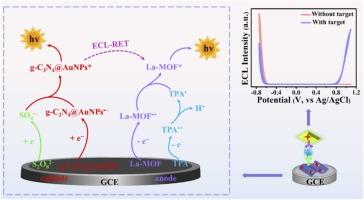基于 La-MOF 的聚集诱导电化学发光共振能量转移和 g-C3N4@AuNPs 的低阴极激发电位的双信号免疫传感器用于定量检测人血清淀粉样蛋白 A
IF 8
1区 化学
Q1 CHEMISTRY, ANALYTICAL
引用次数: 0
摘要
我们报告了一种用于定量检测人血清淀粉样蛋白 A(SAA)的双信号电化学发光(ECL)免疫传感器的开发情况。该免疫传感器由 g-C3N4@AuNPs 作为阴极,镧基金属有机框架 (La-MOF) 作为阳极,后者利用聚集诱导电化学发光 (AIECL) 来克服 H4TBAPy 配体在电极表面的 ECL 强度差的问题。此外,与 H4TBAPy 相比,刚性 MOF 结构显著提高了 La-MOF 的荧光量子产率以及荧光和 ECL 发射。当采用双信号 ECL 免疫传感器检测 SAA 时,在 100 fg/mL-200 ng/mL 的范围内,阳极和阴极 ECL 信号之差与 SAA 浓度的对数呈很强的线性关系,检测限为 24.5 fg/mL。本文章由计算机程序翻译,如有差异,请以英文原文为准。

Dual-signal immunosensor based on aggregation-induced electrochemiluminescence resonance energy transfer of La-MOF and low cathodic excitation potential of g-C3N4@AuNPs for the quantitation of human serum amyloid A
We report on the development of a dual-signal electrochemiluminescence (ECL) immunosensor for the quantitation of human serum amyloid A (SAA). The immunosensor comprises g-C3N4@AuNPs as the cathode and a lanthanum-based metal organic framework (La-MOF) as the anode, the latter of which utilizes aggregation-induced electrochemiluminescence (AIECL) to overcome the otherwise poor ECL intensity of H4TBAPy ligands at the electrode surface. Furthermore, the rigid MOF structure significantly improved the fluorescence quantum yield, as well as the fluorescence and ECL emission, of the La-MOF compared to H4TBAPy. The g-C3N4@AuNPs exhibits an ultrathin nanosheet structure with a low cathodic excitation potential of −0.72 V. When the dual-signal ECL immunosensor was employed to detect SAA, the difference between the anodic and cathodic ECL signals exhibited a strong linear relationship with the logarithm of the SAA concentration in the range of 100 fg/mL–200 ng/mL, with a detection limit of 24.5 fg/mL.
求助全文
通过发布文献求助,成功后即可免费获取论文全文。
去求助
来源期刊

Sensors and Actuators B: Chemical
工程技术-电化学
CiteScore
14.60
自引率
11.90%
发文量
1776
审稿时长
3.2 months
期刊介绍:
Sensors & Actuators, B: Chemical is an international journal focused on the research and development of chemical transducers. It covers chemical sensors and biosensors, chemical actuators, and analytical microsystems. The journal is interdisciplinary, aiming to publish original works showcasing substantial advancements beyond the current state of the art in these fields, with practical applicability to solving meaningful analytical problems. Review articles are accepted by invitation from an Editor of the journal.
 求助内容:
求助内容: 应助结果提醒方式:
应助结果提醒方式:


